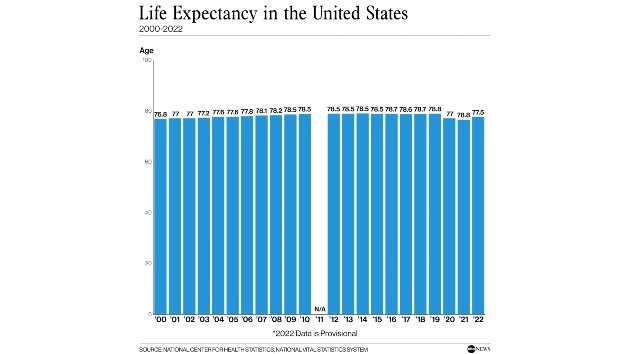(NEW YORK) — After two consecutive years of declines, life expectancy in the United States increased between 2021 and 2022, new provisional federal data shows.
Life expectancy, defined as the average number of years a person is expected to live from the time they are born, rose in the U.S. from 76.4 in 2021 to 77.5 in 2022, a report published early Wednesday by the Centers for Disease Control and Prevention’s National Center for Health Statistics found.
While the increase is notable, it does not fully compensate for the loss of 2.4 years of life expectancy seen from 2019 to 2021, which was mainly due to increases in excess deaths as a result of the COVID-19 pandemic.
Prior to this increase, life expectancy had fallen to the lowest levels seen in 26 years, the data showed.
For the annual report, the NCHS looked at 2022 provisional mortality data and compared it to final 2021 data from the National Vital Statistics System.
The report found that life expectancy differed between sexes, although both saw increases between 2021 and 2022.
Males had a life expectancy of 74.8, an increase of 1.3 years, and females had a life expectancy of 80.2, an increase of 0.9 years. There was still a gap between the sexes, but it decreased to 5.4 years from 5.8.
The authors noted that between 2000 and 2010, the life expectancy between the sexes had narrowed to 4.8, “but then increased in 2020 and 2021 to levels not seen since 1996, when the difference was 6.0 years.”
Life expectancy increased for every racial/ethnic group including 2.3 years for American Indians/Alaska Natives, 2.2 years for Hispanics, 1.6 years for the Black population, 1.0 years for Asians and 0.8 years for the white population.
Despite the increases, American Indians/Alaska Natives had the lowest life expectancy at 67.9 years while Asians had the highest life expectancy at 84.5 years.
Additionally, while life expectancy for Black Americans has been steadily lower than that of white Americans, the gap has been narrowing for nearly three decades, according to the report.
The report also looked at reasons for the increases in life expectancy. For the total population, more than 84% of the increase was credited due to decreases in COVID-19 mortality.
In 2021, there were approximately 460,000 COVID-19 deaths compared to approximately 244,000 COVID-19 deaths in 2022, according to CDC data.
Additionally, decreases in deaths from heart disease, unintentional injuries and cancer as well as homicides helped increase life expectancy.
The authors noted that life expectancy would have been even greater if not for increases in deaths due to influenza and pneumonia; perinatal conditions; kidney disease; nutritional deficiencies; and congenital malformations.
Copyright © 2023, ABC Audio. All rights reserved.












